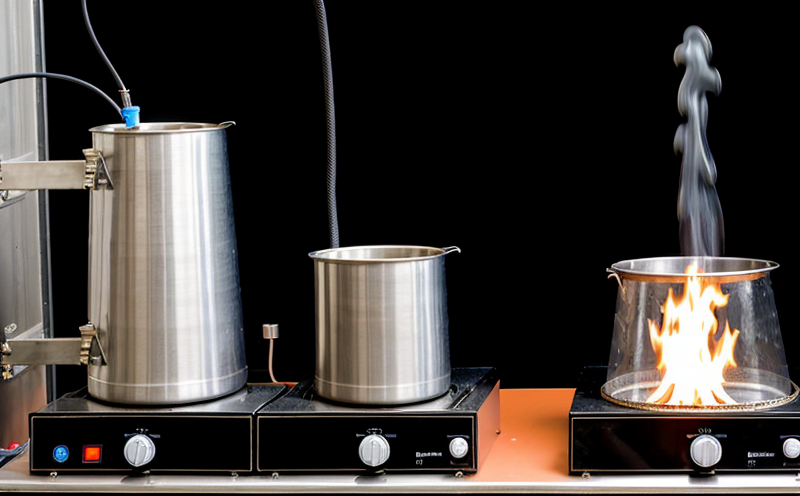Thermal Behavior Analysis of Combustible Materials
In the realm of fire safety testing, understanding the thermal behavior of combustible materials is crucial. This knowledge aids in predicting how materials will react under various heat and flame conditions, which can significantly influence their suitability for specific applications.
The primary objective of Thermal Behavior Analysis (TBA) involves assessing a material's ability to resist ignition, maintain its integrity during exposure to heat, and emit harmful gases or particles. This analysis is particularly relevant in sectors such as construction, textiles, automotive, and electronics, where fire safety regulations are stringent.
During the TBA process, materials undergo controlled heating at specified rates under standardized conditions. The test apparatus measures key parameters including heat release rate (HRR), smoke production rate (SPR), oxygen consumption, and carbon dioxide generation. These metrics help in evaluating a material's flammability characteristics and its potential to contribute to fire spread.
The test setup typically includes an induction furnace or calorimeter capable of generating controlled heat fluxes. The specimen is placed within this apparatus, where it is subjected to temperatures that simulate real-world scenarios such as open flame exposure or radiant heating. Various types of specimens can be analyzed including fabrics, plastics, foam materials, and composites.
The outcome of the TBA test yields detailed reports that detail the thermal stability and flame resistance properties of the tested material. These reports are invaluable for quality managers, compliance officers, R&D engineers, and procurement professionals who need to ensure the safety and performance of their products in fire-prone environments.
Understanding the thermal behavior allows manufacturers and designers to make informed decisions about selecting appropriate materials that meet regulatory requirements and enhance product safety. For instance, a higher HRR indicates greater flammability which might necessitate additional fire retardant treatments or alternative material choices. Similarly, low SPR suggests minimal smoke production under heat stress—a desirable characteristic in environments where smoke inhalation is a risk.
Accurate TBA analysis ensures compliance with international standards like ISO 56601:2013 for calorimetry and ASTM E648-17 for heat release rate testing. By adhering to these standards, laboratories provide reliable data that can be trusted by all stakeholders involved in product development and quality assurance.
Moreover, this analysis contributes significantly towards sustainability goals by helping manufacturers choose materials that are less hazardous when exposed to fire risks. This approach not only protects human life but also reduces environmental impacts associated with fires.
Benefits
The benefits of conducting Thermal Behavior Analysis extend beyond mere compliance; they offer substantial advantages in terms of safety, efficiency, and innovation:
Enhanced Fire Safety: By identifying materials that burn more slowly or produce less smoke, TBA helps prevent fires from spreading rapidly.
Improved Product Quality: Understanding the thermal characteristics aids manufacturers in optimizing their product designs for better performance under fire conditions.
Regulatory Compliance: Meeting stringent fire safety regulations reduces the risk of legal issues and enhances brand reputation.
Economic Savings: Early detection of non-compliant materials through TBA can save costs associated with rework or recalls.
Innovation Opportunities: Insights gained from TBA enable companies to develop safer, more sustainable products that meet evolving market demands.
These benefits underscore the importance of incorporating Thermal Behavior Analysis into any comprehensive fire safety strategy.
Environmental and Sustainability Contributions
The analysis of a material's thermal behavior has direct implications for environmental sustainability. By identifying materials with lower flammability or reduced smoke production, TBA plays a crucial role in minimizing the environmental impact of fires:
Reduction in Carbon Emissions: Materials that produce less CO2 during combustion contribute positively to global efforts against climate change.
Minimized Waste Generation: Safer materials require fewer fire suppression activities, thereby reducing waste and associated disposal costs.
Promotion of Sustainable Practices: Incorporating TBA into product development encourages the use of eco-friendly materials that are inherently safer under fire conditions.
Incorporating these considerations aligns with broader sustainability goals set forth by organizations worldwide, promoting not only safety but also responsible environmental stewardship.
Use Cases and Application Examples
Fabric Selection for Upholstery: When selecting upholstery fabrics, manufacturers use TBA to ensure the chosen materials meet fire safety standards without compromising comfort or aesthetics.
Material Evaluation in Electronics Manufacturing: In the electronics sector, TBA helps evaluate the suitability of different insulating and protective materials used within devices like computers and smartphones.
Aerospace Component Testing: For critical components such as aircraft interiors, TBA ensures that even minor flammable elements are identified early enough to prevent catastrophic failures.
Textile Industry Quality Control: Textile mills utilize TBA during product development stages to ensure their fabrics comply with local and international fire safety regulations.
Construction Material Selection: Construction firms use TBA results when choosing wall insulation materials, ceiling panels, or flooring solutions that enhance building safety.
The versatility of TBA makes it an indispensable tool across multiple industries ensuring both compliance and innovation in product design.





